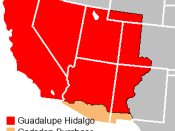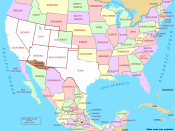I. Background information on Mexican War
A. Happened due to Mexico's stubbornness to sell California and America's annexation of Texas, 1845.
B. The Mexican War started on April 25, 1846 when American troops led by General Zachary Taylor crossed the Nueces River to the Rio Grande.
1. Mexican soldiers attacked and killed or wounded 16 soldiers.
2. The war was also called Polk's war because he sent soldiers to Texas and inadvertently crossed the Nueces River.
C. The Americans then launched on a campaign that led through Mexico and finished at Mexico City.
D. Nicholas Trist was sent to negotiate a treaty with Mexico. He signed the Treaty of Guadalupe Hidalgo on February 2, 1848. America paid $18,250,000, the equivalent of $627,482,629 today, for the rights of Texas and the area stretching westward to Oregon and the ocean, which included California.
E. The Mexican War greatly impacted America in land expansion, slavery, transportation, and practice for the military for the Civil War.
II. How the Mexican War affected land expansion
A. With the Treaty of Guadalupe Hidalgo, America was granted nearly half of Mexico, which increased America by nearly one third. This entire region was about 1.2 million square miles
1. This area included Texas and the California region.
(a) Many expansionists that believed in Manifest Destiny wanted to seize all of Mexico.
B. With the purchase of California, gold was discovered, and this led to the California Gold Rush where millions of Americans sold their belongings and moved west in order to mine gold.
C. Then in 1853, the Gadsden Purchase occurred. America paid $10 million, $343,826,098 today, for 29,640 square miles.
D. With these two purchases, America gained 1.3 million square miles and nearly doubled the size of America.
III. How the Mexican War affected slavery
A. With the great expansion west, settlers wanted to bring slaves with them.
B. In the Wilmot Proviso, the North tried to restrict slavery.
1. Dred Scott v. Sandford, the Wilmot Proviso was declared unconstitutional, and was taken out.
2. The Wilmot Proviso was considered one of the first steps toward the civil war.
C. The Compromise of 1850 was written to address Texas's annexation.
1. The Compromise of 1850 consisted of five individual bills. The five bills that passed were:
(a) California was admitted as a free state.
(b) The slave trade was abolished in the District of Columbia
(c) New Mexico and Utah were organized under the rule of popular sovereignty.
(d) The Fugitive Slave Act was passed.
(e) Texas relinquished lands for $10 million.
D. The Mexican War caused the Compromise of 1850 and passed the Fugitive Slave Act and abolished slave trade in the District of Columbia.
E. All these issues with slavery would lead to the Civil War.
IV. How the Mexican War affected transportation
A. Because California and Oregon were so far away, new land transportation was necessary.
B. The cost of a railroad line was so expensive, that there could only be one line.
1. Because there could only be one line, the North and the South fought over the end of the life. The one that won would win wealth, population, and influence.
C. When Secretary of War Jefferson Davis saw that the best route ran slightly south of Mexico's border, he sent James Gadsden to purchase that land, the Gadsden Purchase.
D. With this new land, a new railroad was built connecting Houston, Texas to Los Angeles, California. This railroad ran through El Paso and Tucson.
1. This railroad was called the Southern Pacific Railroad, completed in 1882.
E. The Mexican War helped to unite the East and the West through a series of railroads.
V. How the Mexican War affected the military
A. The battles in the Mexican War helped provide experience for Captain Robert E. Lee and Lieutenant Ulysses S. Grant. This would help them later in the Civil War.
B. The Military Academy at West Point was justified.
C. Navy Secretary and historian George Bancroft to help teach naval officers, established a new academy at Annapolis in 1846.
D. The Mexican war helped to teach officers about the field and helped to create new warriors to fight in the Civil War.
VI. Summarizing the impact of the Mexican War
A. The Mexican War provided a huge amount of land for expansion.
1. Around 1.3 million square miles was bought from Mexico for $28,250,000, roughly $971,308,727 today.
B. The Mexican War provided new laws dealing with slavery.
1. The Wilmot Proviso was passed, and ruled unconstitutional. The Compromise of 1850 was also passed.
(a) Fugitive Slave law was passed in Compromise of 1850.
C. The Mexican War provided new transportation.
1. The East and the West needed to be connected, so railroads were built.
D. The Mexican War helped to train the military.
1. Many soldiers were trained in this war; these soldiers would later fight in the Civil War. Such soldiers included Ulysses S. Grant and Robert E. Lee.
Bibliography:
"Compromise of 1850." Compromise of 1850. 13 Dec. 2005. 13 Dec. 2005 .
Kennedy, David, Lizabeth Cohen, and Thomas Bailey. The American Pageant. 13th ed. Boston: Houghton Mifflin Company, 2006.
"Mexican-American War." Mexican-American War. 13 Dec. 2005. 13 Dec. 2005 .
"The Mexican War." The Mexican War. 2 Aug. 2004. Lone Star Internet. 13 Dec. 2005 .
"Wilmot Proviso." Wilmot Proviso. 13 Dec. 2005. 13 Dec. 2005 .


